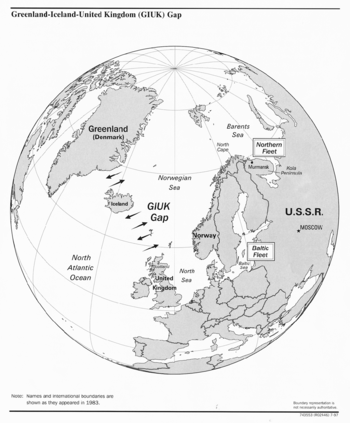GIUK gap

The GIUK gap is an area in the northern Atlantic Ocean that forms a naval choke point. Its name is an acronym for Greenland, Iceland, and the United Kingdom, the gap being the open ocean between these three landmasses. The term is typically used in relation to military topics.
Importance to the Royal Navy
The GIUK gap was particularly important to the British Royal Navy, as any attempt by northern European forces to break into the open Atlantic would have to be made either through the heavily defended English Channel, one of the world's busiest seaways,[1] or through one of the exits on either side of Iceland. As the British also control the strategic port of Gibraltar at the entrance to the Mediterranean, this means Spain, France, and Portugal are the only Continental European countries that possess direct access to the Atlantic Ocean that cannot easily be blocked at a choke point by the Royal Navy.
History
Since the beginning of the twentieth century, the exploitation of the GIUK gap by northern forces and measures to patrol and secure the gap by opposing forces have played an important role in naval and in overall military planning.
World War II
From the start of World War II in 1939, German ships used the gap to break out from their bases in northern Germany (and from occupied Norway after April 1940) with a view to attacking Allied shipping convoys, but Allied blocking efforts in the North Sea and in the GIUK gap impeded such break-outs. British forces occupied the Faroe Islands in April 1940, and Iceland in May 1940; the United States of America took over effective control of Greenland in 1940. But the German Kriegsmarine profited greatly from the fall of France in June 1940, after which German submarines could operate from bases on the French coast. Between 1940 and 1942 the Denmark Strait between Iceland and Greenland remained one of the few areas that RAF patrol bombers could not reach, and thus became the centre for considerable action.
The origin of the term "gap" dates to this period, when there was a gap in air coverage known as the Mid-Atlantic gap or the "Greenland air gap". This gap was an area that land-based aircraft could not reach and where, as a result, they could not carry out their anti-submarine duties. The air-surveillance gap eventually closed in 1943 when longer-ranged versions of aircraft such as the Short Sunderland and B-24 Liberator came into service.
Cold War
The GIUK gap again became the focus of naval planning in the 1950s, as it represented the only available outlet into the Atlantic Ocean for Soviet submarines operating from their bases on the Kola Peninsula. NATO worried that if the Cold War "turned hot", naval convoys reinforcing Europe from the U.S. would suffer unacceptable losses if Soviet submarines could operate in the North Atlantic. The United States and Britain based much of their post-war naval strategy on blocking the gap, eventually installing a chain of underwater listening posts right across it - an example of a SOSUS "sound surveillance system".
The Royal Navy's primary mission during the Cold War, excluding its nuclear deterrent role, involved anti-submarine warfare (ASW). The development of the Invincible-class anti-submarine carriers stemmed from this doctrine: their primary mission involved anti-submarine warfare using Sea King helicopters. The Type 23 frigate originated as a pure ASW platform; its mission expanded following the Falklands War of 1982.
The Soviets planned to use the GIUK gap to intercept any NATO ships, especially aircraft carriers, heading towards the Soviet Union. Ships and submarines as well as Tupolev Tu-142 maritime-surveillance aircraft aimed to track any threatening ships.
Bird migration
The GIUK gap is also a route for migratory birds such as the northern wheatear to cross the Atlantic to reach Greenland and eastern Canada.
In popular culture
- The GIUK line is mentioned in the film The Bedford Incident.
- In Tom Clancy's first novel The Hunt for Red October, the line was used to detect Soviet submarines entering the North Atlantic in pursuit of the rogue Typhoon-class submarine Red October, whose officers were defecting to the United States with clandestine stealth technology. The event causes significant political and military tension between the United States and the Soviet Union.
- In Clancy's second novel Red Storm Rising, the line is featured more prominently after a war breaks out between NATO and the Warsaw Pact. The Soviet Union launches a surprise attack on the NATO airbase NAS Keflavik and invades Iceland. This causes the line to be destroyed, creating a gap in NATO's surveillance and allowing the Soviet Navy to enter the North Atlantic. The subsequent Soviet submarine attacks and air raids cause serious damage to Merchant Marine ships and naval vessels in Atlantic convoys, hindering NATO's war effort during the defense against the less-successful Soviet invasion of West Germany
- Early editions of the Harpoon naval warfare simulation were based around defending the GIUK Gap. Tom Clancy used the simulation to test the naval battles for Red Storm Rising.[2]
- The location of Iceland in the gap made it a participant in the Cold War and a target for a nuclear strike, especially through the introduction of the aforementioned atomic bomber NATO base. Halldór Laxness dramatized the tension of these geopolitics from the perspective of an Icelandic maid in the novel The Atom Station.
See also
- Battle of the Denmark Strait
- Broad Fourteens
- Communication with submarines
- Long Forties
- Mid-Atlantic gap
- SOSUS
- Western Approaches
Land:
References
- ↑ "The Dover Strait". Maritime and Coastguard Agency. 2007. Retrieved 2010-04-17.
- ↑ "Harpoon Naval Warfare Simulation Game - AGSI - Harpoon Commanders Edition (HCE)".